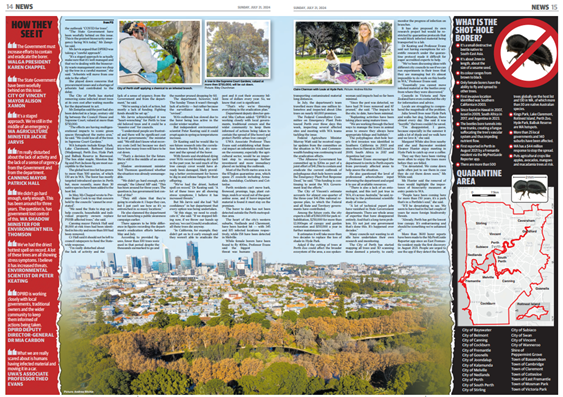WALGA is calling on the State Government to intensify its Polyphagous shot-hole borer (PSHB) eradication efforts, by stepping up to help Councils, households and individual property owners replace trees affected by the borer.
This resulted in WALGA leading a public push in the mainstream media that was covered extensively by print, television, radio and online media outlets over Sunday 21 and Monday 22 July 2024.
Coverage
Sunday 21 July 2024
- Sunday Times double page spread and The West online

TV News items
- Channel 10 5:00 PM News – Jess Hayes
- Channel 7 6:00 PM News - Geof Parry
- Channel 9 6:00 PM News – Michael Genovese
- ABC News 7:00 PM - Nic Perpitch
Featured: Karen Chappel (WALGA), Mayor Alison Xamon (City of Vincent), Agriculture Minister Hon Jackie Jarvis, Lord Mayor Basil Zempilas (City of Perth), Mayor Patrick Hall (City of Canning).



Monday 22 July 2024
Radio
- 6pr Mornings Show – Gary Adshead 10:05 AM
Featured: Karen Chappel (WALGA) and Hon Jackie Jarvis, Agriculture Minister
- Op-Ed by Karen Chappel AM JP
The below opinion piece by WALGA President Karen Chappel AM JP was featured in The West Australian
Tiny pest will break hearts
Many of Perth’s much-loved mature trees are being cut down and mulched as an insect the size of a sesame seed wreaks havoc across a large part of the metropolitan area.
The Polyphagous shot-hole borer (PSHB) is attacking and killing trees like the Moreton Bay Fig, the London Plane Tree, and the Box Elder Maple, community favourites that people love.
There is currently no effective treatment for the borer – the only way to contain the spread is to remove the infested trees.
Over 3,000 trees that have provided canopy for shade, habitat for our wildlife, and have beautified communities for decades, have been cut down and destroyed so far, including in some of our most iconic locations - King’s Park, Perth Zoo, Hyde Park and Rottnest Island, as well as in people’s yards and suburban streets. Many more infested trees are slated for removal in coming months.
The PSHB outbreak is being managed by the State Government. When the borer is found in your yard or suburb, your Local Council works with the State Government to remove and destroy infected trees.
These efforts have not been enough to contain the spread of the borer. Since 2021 the PSHB Quarantine Area has gradually increased to cover 88 suburbs across 25 metropolitan Councils.
This is entirely consistent with the impact the borer has had on mature canopies in other parts of the world. Images of the devastating impact of the borer on Southern California should be all the warning we need to respond with every resource at our disposal.
With the female borer being able to reproduce on her own, fly up to 400m to find a suitable host tree, and live in garden cuttings and green waste, there is a real possibility that the borer will spread well beyond the existing quarantine area.
This could see the infestation heading north into Wanneroo and Joondalup, east into Gosnells, Armadale and Kelmscott, and south into Kwinana and Rockingham.
What happens if the borer reaches our horticultural regions?
If the decision is made that PSHB can’t be eradicated and that we have to move to living with the borer, the responsibility - and cost – of managing infected trees and replacing them will likely fall to landowners. That means Local Governments, households, and individual property owners.
Local Councils are already doing what they can to plant more trees and retain the ones they have. They simply do not have the additional resources to meet the cost of tree removal or to replace PSHB infested trees. In the midst of a cost-of- living crisis, neither do families or individual property owners.
WALGA has been imploring the State Government to escalate existing efforts and commit additional funding to eradicate the borer and rebuild our lost tree canopy, which, at 16%, is already the lowest of any major Australian city - and dwindling. We can’t afford to lose any more mature, established trees.
We need the State to step up to help Councils, households and individual property owners replace PSHB-affected trees.
We simply must not resign ourselves to tree removal being the only effective treatment for the borer. We have some of the world's brightest minds who must be engaged and resourced to find alternative treatments that protect this critical resource.
While the State Government is to be commended for its commitment to develop an urban greening strategy for Perth and Peel, this will be futile if the Government doesn’t activate a PSHB recovery plan.
The Government must increase efforts to contain and eradicate the borer. It needs to prioritise replacing the thousands of trees already lost. With every day that we delay, the borer spreads further and more generations of Western Australians will be impacted.
Critically, planning for recovery and transitioning to management must be undertaken now.
Waiting until it's determined that the borer can't be eradicated will further exacerbate its impact.
The State Government needs to do more, now.


